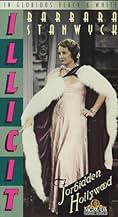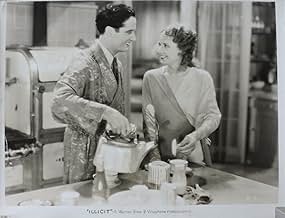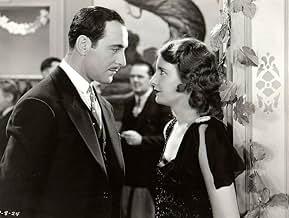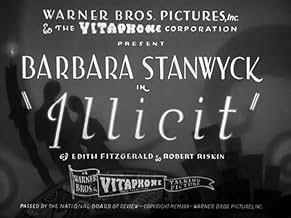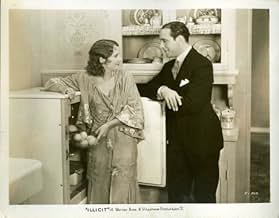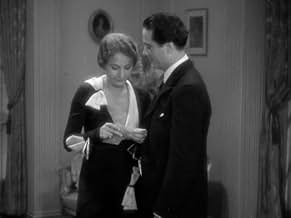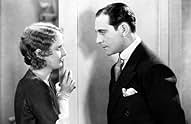CALIFICACIÓN DE IMDb
6.1/10
1.3 k
TU CALIFICACIÓN
Ann, una joven de ideas escandalosamente "avanzadas", ha estado viviendo en pecado con su amante, Dick, debido a su convicción de que el matrimonio destruiría su amor conyugal.Ann, una joven de ideas escandalosamente "avanzadas", ha estado viviendo en pecado con su amante, Dick, debido a su convicción de que el matrimonio destruiría su amor conyugal.Ann, una joven de ideas escandalosamente "avanzadas", ha estado viviendo en pecado con su amante, Dick, debido a su convicción de que el matrimonio destruiría su amor conyugal.
- Dirección
- Guionistas
- Elenco
- Premios
- 2 premios ganados en total
Hazel Howell
- Girl at the Bridal Shower
- (sin créditos)
Lucille Ward
- Susan - Anne's Maid
- (sin créditos)
Barbara Weeks
- Girl at the Bridal Shower
- (sin créditos)
- Dirección
- Guionistas
- Todo el elenco y el equipo
- Producción, taquilla y más en IMDbPro
Opiniones destacadas
This movie creaks with age, but is memorable for being Barbara Stanwyck's first movie as a star. Miss Stanwyck gives an excellent performance, as always, but the supporting cast, particularly Charles Butterworth, steals the show as an amiable drunk whose bark is worse than his bite.
it is the man in a so-called "illicit" relationship who longs to get married and avoid a reputation, while Ann, played by Barbara Stanwyck holds out. She doesn't have much faith in marriage. But she is eventually convinced, in part by her lover's father. Will she be happy, or proved right, that is the question of the film.
Barbara looks lovely in this film, with darker hair (even though tight satin gowns are very unforgiving). She plays a modern woman, and does so with charm, instead of stridency. As newlyweds, they are blissfully happy, with plenty of money, travels and a beautiful townhouse in Manhattan. But hubby (James Rennie, who was married to Dorothy Gish for a while) is still a bit of a stiff....he complains when Ann turns on the music after a dinner out. She wants to go dancing, he whines about the late hour. Besides he might be catching a cold. Boo hoo. Yet when his friends call up, suddenly he is raring to go. And Ann knows why-he is still carrying a torch for a former girlfriend.
Joan Blondell is smart and chic in a small role.
(One of the most unrealistic lines is when Ann tells her husband she is going to move back to her old place for a while, tonight, right away. Try that in NYC...)
Barbara looks lovely in this film, with darker hair (even though tight satin gowns are very unforgiving). She plays a modern woman, and does so with charm, instead of stridency. As newlyweds, they are blissfully happy, with plenty of money, travels and a beautiful townhouse in Manhattan. But hubby (James Rennie, who was married to Dorothy Gish for a while) is still a bit of a stiff....he complains when Ann turns on the music after a dinner out. She wants to go dancing, he whines about the late hour. Besides he might be catching a cold. Boo hoo. Yet when his friends call up, suddenly he is raring to go. And Ann knows why-he is still carrying a torch for a former girlfriend.
Joan Blondell is smart and chic in a small role.
(One of the most unrealistic lines is when Ann tells her husband she is going to move back to her old place for a while, tonight, right away. Try that in NYC...)
The best part of this rather boring gabfest is getting to see ladies high-fashion outfits, circa 1930. Some of them are real doozies. Stanwyck gets more than her share of slinky finery as a rich guy's paramour. Actually, the movie's premise is a significant one—does marriage somehow kill love? Anne (Stanwyck) seems to think so and sometimes acts on the premise. The trouble is that the premise gets drowned out by all the talk from one scene to the next, without let-up. Then too, director Mayo adds nothing to what turns out to be a filmed stage play. To be charitable, his options may have been cramped by the newness of movie sound equipment.
Pre-Code liberties are evident in the first few scenes where Anne, in a clinging negligee, and Dick (Rennie) discuss whether to marry or to continue living in sin. After that, the screenplay settles into more conventional marital mix-ups. But at least Stanwyck shines, showing why she was slated for bigger and better things. In fact, she's almost girlish, a really long way from the femme fatale of Double Indemnity (1944). Too bad she doesn't have more scenes with that other Warner's personality girl, Joan Blondell (Duckie). Anyway, I found the movie considerably less than I expected.
Pre-Code liberties are evident in the first few scenes where Anne, in a clinging negligee, and Dick (Rennie) discuss whether to marry or to continue living in sin. After that, the screenplay settles into more conventional marital mix-ups. But at least Stanwyck shines, showing why she was slated for bigger and better things. In fact, she's almost girlish, a really long way from the femme fatale of Double Indemnity (1944). Too bad she doesn't have more scenes with that other Warner's personality girl, Joan Blondell (Duckie). Anyway, I found the movie considerably less than I expected.
In 1931, Stanwyck was still a young girl, with her LONG hair, child-like innocent manner, and round kid face. As Anne Vincent, she wants to stay single and happy, while her beau Dick (James Rennie) wants to get married. Along for fun is Charles Butterworth as George, Dick's sidekick. He tells the couple that they have been discovered, and totters off, for more drinks... Ricardo Cortez is also here as the ex-boyfriend Baines to stir things up; Stanwyck and Cortez had worked together on three films together in the 1930s. Look for a 25 year old Joan Blondell as Helen Childers, Anne's friend, in one of her early roles. Will things stay the same if they get married? That's the big question. Kind of a statement of the times, and even more so in a couple years when the production code will keep everything on the up and up, even when they aren't. This was Darryl Zanuck's 12th film as producer. Towards the middle of the version shown on Turner Classics, there are scratches or wear marks on the right side of the screen, not surprising for such an old film. Interesting to watch, but no big surprises.
The naming of this film must have been just to attract Depression era audiences, because there is nothing really illicit about it. However, it is a very modern look at romance and marriage considering it was made in 1931. Barbara Stanwyck plays Anne Vincent, a modern woman who is afraid that her relationship with boyfriend Richard Ives will be changed by marriage. She bases her beliefs on watching her own parents and her friends. In her parents' case she says that she knows they loved each other, but divorced anyways, and she is sure that separation from one another is what killed them. However, social pressures prevail and the two do get married.
Anne's fears become realized as Richard seems to only be interested in going out when it involves other people, not just Anne. She sees him out with another woman one night when he is supposed to be working, and she decides what the two need is a trial separation from one another - to become individuals again. Throw Ricardo Cortez into the mix as someone who wants Anne's marriage to not work out, and you have the makings of an above average potboiler from the precode era.
This film is mainly interesting because of Stanwyck. Without her abilities this would be a pretty forgettable film. And those fashions! With all of the ermine and feathers, this film has Barbara Stanwyck venturing into Kay Francis territory. Also lending good support is Charles Butterworth as the seldom sober friend to the young couple, and the always wonderful Joan Blondell as Anne's close friend.
Anne's fears become realized as Richard seems to only be interested in going out when it involves other people, not just Anne. She sees him out with another woman one night when he is supposed to be working, and she decides what the two need is a trial separation from one another - to become individuals again. Throw Ricardo Cortez into the mix as someone who wants Anne's marriage to not work out, and you have the makings of an above average potboiler from the precode era.
This film is mainly interesting because of Stanwyck. Without her abilities this would be a pretty forgettable film. And those fashions! With all of the ermine and feathers, this film has Barbara Stanwyck venturing into Kay Francis territory. Also lending good support is Charles Butterworth as the seldom sober friend to the young couple, and the always wonderful Joan Blondell as Anne's close friend.
¿Sabías que…?
- TriviaOn the phone, Dick and Anne tease Duckie that they can't agree on which vacuum cleaner to buy, a Peerless or a General Electric. The joke here appears to be that Peerless was an old maker of hand-pump vacuums, never electric ones.
- Errores(at around 5 mins) As Dick and Anne are walking out of the kitchen, a moving shadow of the boom microphone is visible on the wall to the left.
- Citas
Richard 'Dick' Ives II: Dad, what would you do with a girl like that?
Richard Ives Sr.: I'd grab her any way she'd have me.
- ConexionesFeatured in Sex, Censorship and the Silver Screen: The Temptations of Eve (1996)
- Bandas sonorasMaybe It's Love
(1930) (uncredited)
Music by George W. Meyer
Lyrics by Sidney D. Mitchell and Archie Gottler
Whistled by James Rennie
Hummed and sung by Barbara Stanwyck
Selecciones populares
Inicia sesión para calificar y agrega a la lista de videos para obtener recomendaciones personalizadas
- How long is Illicit?Con tecnología de Alexa
Detalles
Taquilla
- Presupuesto
- USD 249,000 (estimado)
- Tiempo de ejecución1 hora 19 minutos
- Color
Contribuir a esta página
Sugiere una edición o agrega el contenido que falta

Principales brechas de datos
By what name was Lo ilícito (1931) officially released in India in English?
Responda
